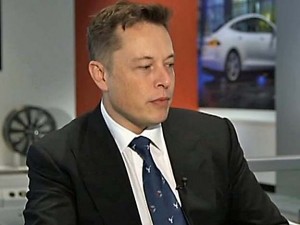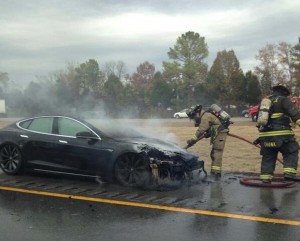
Tesla CEO Elon Musk said the company asked for the National Highway Traffic Safety Administration to open an investigation into the fires plaguing the Model S in recent months. Safety officials have denied that claim.
What’s clear is that the federal government has opened an investigation into the three fires involving Tesla vehicles – and the potential that the Model S battery-electric vehicle suffers from a significant safety design defect. What’s less clear is how that probe got underway after an initial delay.
In a blog posting that came out earlier this week, Tesla CEO and founder Elon Musk declared that his company asked the National Highway Traffic Safety Administration (NHTSA) to launch its probe. But during a tour of the L.A. Auto Show, NHTSA Director David Strickland stressed that was news to him.
The head of the federal government’s automotive safety arm first noted that during a hearing on Capitol Hill this week, later repeating that the decision to launch the investigation was made “independently,” with no feedback from Tesla or its CEO, despite Musk’s blog claiming the company “requested” a safety probe “as soon as possible into the fire incidents.”

An Instagram image of a third reported Tesla Model S fire in Smyrna, Tennessee. Photo Credit: TeslaMotorsClub.com.
What is known is that three fires involving Tesla vehicles have occurred since late September, and while one followed a high-speed crash, the first and third of the blazes have been linked to damage caused by road debris striking and penetrating the armor protecting the underside of the Model S battery pack.
A probe, several well-versed observers have suggested, could focus on such questions as whether the protective metal shield at the bottom of the electric vehicle’s batteries is thick enough to withstand a reasonable impact, but the broader concern is whether Tesla’s battery pack design might itself be contributing to the problem.
A significant concern being raised by many within the auto industry is whether the chemistry Tesla adopted for the Model S is particularly prone to catching fire if there is damage to the batteries. Though it could be months before NHTSA’s new probe yields any results, a worse-case scenario, several industry analysts warn, would be that the government finds a major flaw making those batteries unacceptably vulnerable to catching fire.
“If there’s a major design flaw, they’d be in serious trouble,” said George Peterson, senior analyst with AutoPacific, Inc. Should one be discovered, said Peterson, it then becomes a question of if and how it could be fixed. A worst-case scenario might involve the discovery that the batteries used by Tesla are too volatile for use in an automobile.
There has long been concerns, in general, about the safety of lithium-ion technology, which has been linked to a number of fires, including one involving a Sony battery factory and another that is believed to have caused a Mideast cargo plane crash. That has led to restrictions by U.S. aviation authorities on the shipping of lithium-based batteries.
Experts caution that there are, in fact, a number of different chemical “families” of lithium-ion chemistry, some more prone than others to be ignited if a battery is damaged. That led General Motors to skip what could have been the most powerful batteries available for its Chevrolet Volt plug-in hybrid, former GM Vice Chairman and “car czar” Bob Lutz told TheDetroitBureau.com, the maker sacrificing about 10% of the potential power to reduce the risk of such a catastrophic situation.
One Volt battery did catch fire following a NHTSA crash test, though it was later determined the problem was due to testing procedure problems. Nonetheless, GM decided to recall early Volts to increase battery armoring and prevent potential problems involving leakage from the battery pack cooling system.
(NHTSA formally investigating Tesla Model S fires. For more, Click Here.)
Conversations with numerous industry officials, including many directly involved in the battery end of electric vehicle design, found consensus that the most risky lithium chemistry to be that based on the use of the metal cobalt – a formulation linked to the Sony fire and early troubles that several makers, including Toyota, experienced during battery car development.
Tesla – which has made a point of delivering as much as three times the range of other battery vehicles – uses cobalt-based batteries in the Model S supplied by Japan’s Panasonic. The partners, in fact, recently inked a deal that would begin ramping up the availability of such batteries starting in 2014.
(Click Here to read about three injured Tesla employees.)
Tesla officials, including Musk, have insisted that they previously tested their batteries and found them entirely safe. But the fact that damage by road debris could quickly set off a conflagration is raising serious questions about such assertions.
The credibility of the maker and its founder has also come into play, not only because of Musk’s now-dismissed assertions that Tesla triggered the federal probe, but also because of his conflicting comments about what the maker would do if there proves to be a design problem.
Earlier this month, Musk declared there would be “no recall.” But in this week’s blog posting, the South African-born executive seemingly reversed course, writing on his blog that, “While we think it is highly unlikely, if something is discovered that would result in a material improvement in occupant fire safety, we will immediately apply that change to new cars and offer it as a free retrofit to all existing cars.”
That would appear to translate into a recall.
One thing is clear: investors have been growing increasingly worried about the Tesla battery issue, the maker’s once high-flying stock plunging from a peak of $194.50 a share in late September to barely $120 in recent days – though it did rebound a bit today in early morning trading.

Seems like the established automakers
are using different battery formulations
they have been at it a lot longer
maybe Tesla should have also ?
Musk is desperately hoping he can convince NHTSA and consumers that there is no issues with his products but he may be wrong on all counts.